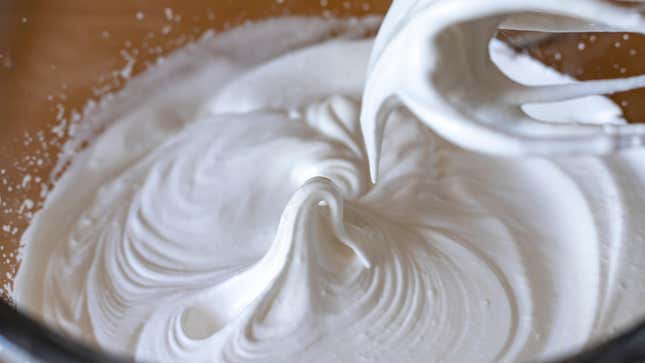
Following recipes can be complicated, especially if you’re new to reading food lingo. With odd jargon like “folding into the batter” or “whipping to stiff peaks,” it’s no wonder a lot of folks decide baking isn’t for them. Everything from whipping cream to baking a souflée can be impacted by your peaks. Let’s shed a little light on what this terminology means and how to recognize the difference in texture.
This is part of The Grown-Up Kitchen, Skillet’s series designed to answer your most basic culinary questions and fill in any gaps that may be missing in your home chef education.
Usually you’ll see the terms “soft peak,” “medium peak,” and “stiff (or firm) peak” when whipping an ingredient. “Peak” refers to the shape the whipped ingredient will take when you lift up the beaters or whisk. The whipped mass will form a point, or peak. It’s the subtle difference in how this peak looks that categorizes it.
The most commonly whipped ingredients that get defined by “peaks” are heavy cream, and egg whites. (I’m not including whipped whole eggs and egg yolks in this because there is a different set of terminology for their whipped texture.) Structurally, these two ingredients can make a big impact when whipped and added to other ingredients, adding aeration, lift, and bulk. Incorporating air can be a messy business. If you over-whip your egg whites, you could end up with a dry meringue or deflated souflée. Under-whip your heavy cream and your icebox cake could slide apart.
I used whipped cream in my pictures, but keep in mind that whipped egg whites usually involve a high ratio of sugar, and so they will look a bit shinier, strike more elastic, defined peaks, and may take a little longer to get to each stage.
Soft peaks
Soft peaks have the loosest texture of the three peaks. Make no mistake, you still have to whip the heck out of the eggs or cream to get here. Egg whites will no longer have a gooey liquid puddle at the bottom, and they’ll be way past the foamy, big bubble state. Likewise, heavy cream will no longer have any liquid gathering at the bottom. The bubbles will be fine and close together, and it will have an overall shiny look.
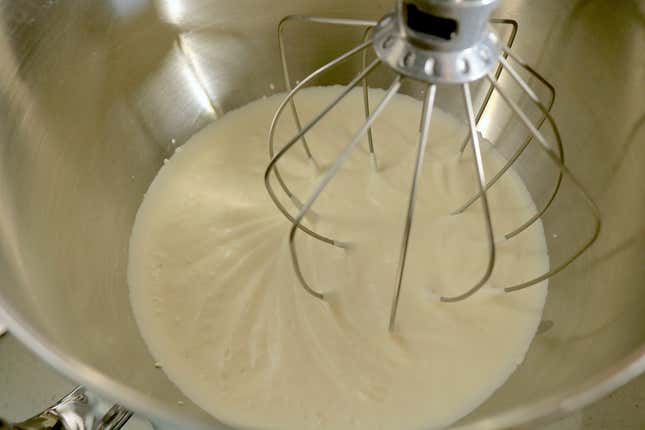
You’ll know you’re just about at that stage when you see lines dragging around the whisk. It’ll look kind of like rippled fabric. Stop whisking and remove the beater. The peak left behind, or the peak on the tip of the whisk will fully flop over and have a rounded off, soft look. It might even be a stretch to say whipped cream has a soft “peak” because it’s not exactly pointy.
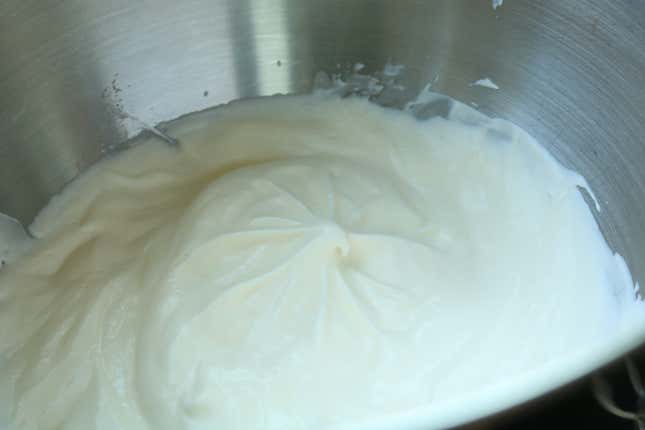
Soft peak stage is silky and light. It holds a globular form but it’s too loose to pipe into shapes and quickly relaxes when you scoop it. Soft peak whipped cream is perfect to dollop on a pie or cake, and egg whites whipped to this stage can be used to give subtle aeration in recipes like pancakes or waffles.
Medium peaks
Most recipes that require whipped egg whites or cream to be folded into a base will specify a medium peak, or maybe medium-firm. (“Folding” is a term for gently mixing in a specific way to conserve bubbles and aeration.) Medium peaks are ideal for many applications because they’re firmer than soft peaks, and hold onto more air bubbles, but softer than stiff peaks, which means it isn’t as stubborn and will blend into other substances (bases) more readily.
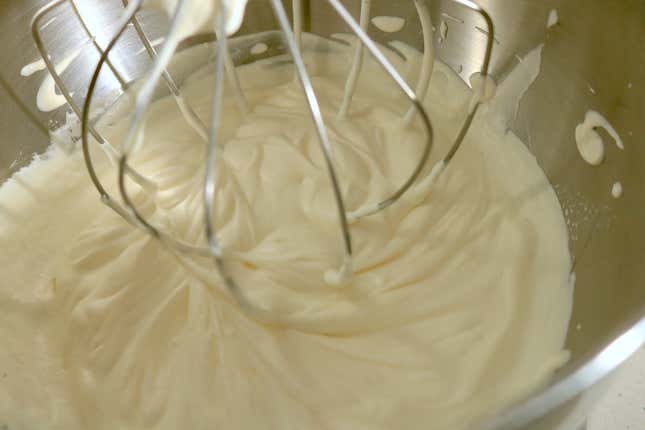
In regards to recipes that finish in the oven, medium peaks mean that the egg whites aren’t yet at their maximum capacity of holding bubbles. This is optimal for recipes that rely on whipped eggs for leavening. Air bubbles will expand in the heat of the oven, and medium peak means the proteins still have the ability to stretch a little farther without losing their captured air pockets.
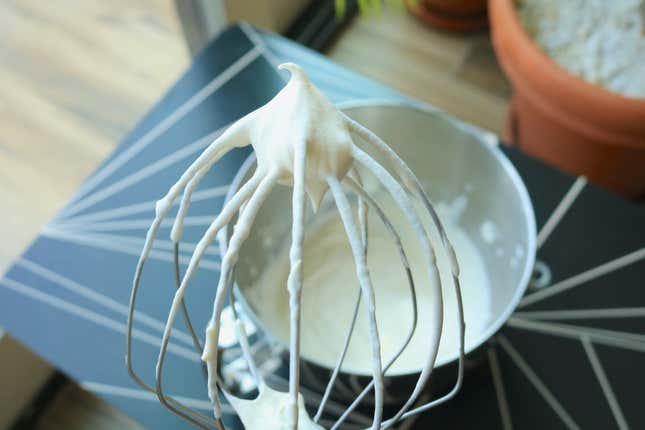
After soft peak, you’ll reach medium peak within about a minute of beating, so be ready. Medium peaks are still silky and glossy. The bubbles are super-fine, and hard to spot as individuals at this point. You’ll know you’re at this stage when the ripples look more like deep folds. Pull the whisk out of the bowl and hold it straight up in the air, pointing at the ceiling. The peak will curl or flop slightly, but hold a defined shape and point.
Stiff peaks
Stiff peak stage is most often called for when the egg whites or cream will be performing solo. The structure is the most stable, it can stand on its own, be shaped and piped to decorate cakes, or make tidy meringue cookies. The whipped ingredient is packed with air and the fats or proteins are tightly bound, holding a maximum capacity of air bubbles.
Stiff peaks aren’t ideal for lightening other mixtures, which is why I call stiff peaks stubborn. Cream or egg whites whipped to stiff peaks really like to stick together at this point, and by the time you convince it all to blend in, you’ve lost a lot of the air.
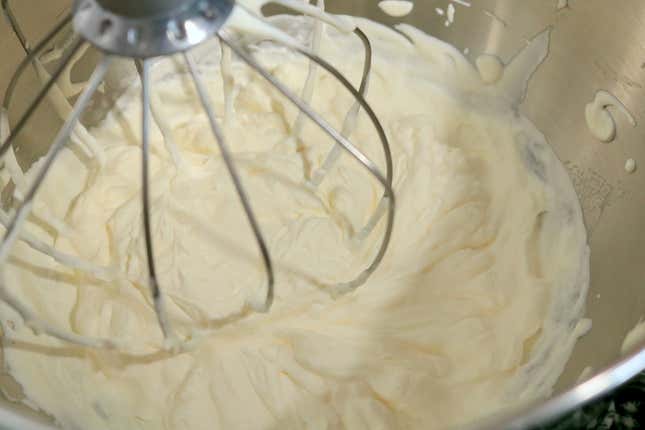
Stiff peaks occur within a scarce 30 to 40 seconds past medium peaks, so be vigilant. If pushed beyond this stage the structure starts to fail and undesirable changes will occur–cream becomes gritty, releases water, and turns to butter; egg whites will become lumpy and look dry, and eventually pool up with liquid too.
You’ll know you’re close when the mixture is thick and billowing, making deep valleys and folds that hold their shape around the whisk. It should still look glossy and luxurious. Hurry and turn off the machine if the mixture becomes so thick you can see the bottom of the bowl reveal itself.
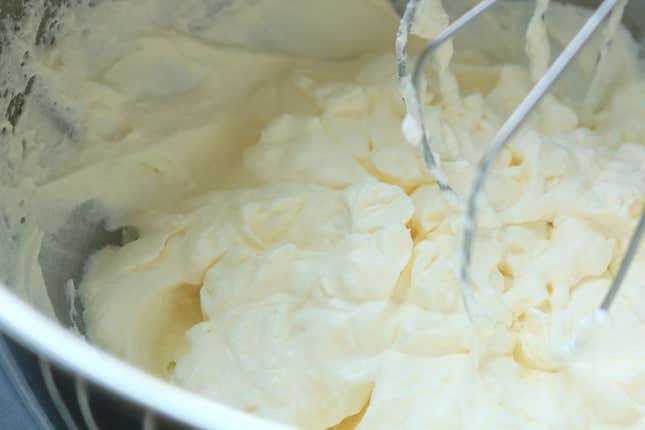
For whipped cream, when you remove the whisk, the cream will hold its shape, leaving spaces where the whisk wires were. For meringue, the mixture will feel stronger, and it will stretch into a sharp, straight peak when you pull the whisk out. Some folks like to flip over the bowl of meringue to “test” if it’s at the right stage because the meringue won’t slide out of the bowl at stiff peak stage. I do not do this because what a dumb waste that would be if it needed a few more minutes of whisking.
Now that you have more of an idea about soft, medium, and stiff peaks, you can explore the dessert world with a ready whisk. You’ll be able to tackle recipes like Japanese fluffy pancakes, chocolate mousse, and pavlovas.
